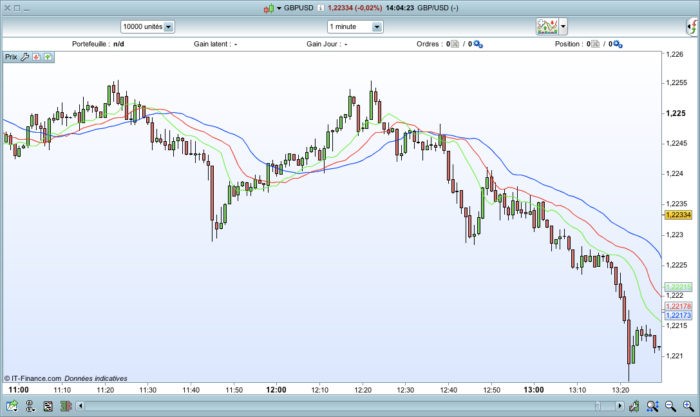What is the Williams Alligator Indicator and how do you trade it?
The legendary trader Bill Williams, an early pioneer of market psychology, developed the trend-following Alligator Indicator, also known as the Crocodile Jaw Charts which follows the premise that financial markets and individual securities trend only 15% to 30% of the time while grinding sideways ranges from the other 70% to 85% of the time. Williams believed that individuals and institutions tend to collect most Williams believed that individuals and institutions tend to collect most of their profits during strongly trending periods.
How the Williams Alligator Indicator works
The Alligator Indicator uses three smoothed moving averages, set at five, eight and 13 periods, all of which are Fibonacci numbers. The initial smoothed average is calculated using a simple moving average (SMA), which adds additional smoothed averages that slow down the indicator turns.
Calculation of the Alligator Indicator
Simple moving average (SMA):
1. SUM1 = SUM (CLOSE, N)
2. SMMA1 = SUM1/N
3. subsequent values are:
4. PREVSUM = SMMA(i-1) *N
5. SMMA(i) = (PREVSUM-SMMA(i-1)+CLOSE(i))/N
There:
– SUM1 – the sum of final courses for N periods;
– PREVSUM – smoothed sum of the previous bar;
– SMMA1 – smoothed moving average of the first bar;
– SMMA(i) – smoothed moving average of the current bar (except the first one);
– CLOSE(i) – current closing price;
– N – the smoothing period.
How the indicator is calculated is important to understand the inner workings of the indicator. Fortunately, the calculation is not required in practice. The Alligator indicator can be added to your charts from the indicator list on your trading platform.
The three moving averages cover the Alligator’s jaw, teeth and lips, opening and closing in response to developing trends and trading ranges:
1. Jaw (blue line): Starts with 13-stroke SMMA and is leveled with eight bars on subsequent values.
2. Teeth (red line): Starts with the eight-step SMMA and levels off with five bars on subsequent values.
3. Lips (green line): Starts with the five-stroke SMMA and is smoothed with three dashes on subsequent values.
Williams invoked barnyard images to describe the indicator, noting “even a blind chicken will find its corn if it is always fed at the same time… it took us years but we have developed an indicator that allows us to always keep our powder dry until we reach the blind chicken’s market.”
Specific considerations
The indicator applies convergence-divergence relationships to build trading signals, where the jaw makes the slowest turns and the lips make the fastest turns. The lips crossing down through the other lines signal a short selling opportunity while crossing upwards signals a buying opportunity. Williams refers to the descending cross as the alligator “sleeping” and the ascending cross as the alligator “awakening”.
The three lines stretched apart and moving higher or lower indicate trend periods during which long or short positions should be maintained and managed. This is called the alligator “eating with its mouth wide open.” Indicator lines that converge into narrow bands and shift towards a horizontal direction indicate periods when the trend may be coming to an end, signaling the need for profit-taking and position reversal. This indicates that the alligator is ‘satiated’.
The indicator flashes a false positive when the three lines cross each other repeatedly, due to choppy market conditions. According to Williams, the alligator is “asleep” at this time. Remains on the sidelines until it wakes up again. This exposes a significant disadvantage of the indicator as many wake-up signals within large distances will fail, triggering whipsaws.
Example of the Williams Alligator Indicator
 The GBPUSD currency pair, known as “the cable” has an alligator “wake-up” signal near the lower left part of the chart, and then begins a strong uptrend showing an alligator “eating with its mouth open” phase. On the rise, the price drops to the Jawline, but the indicators do not cross each other. The trend continues upwards. An alligator “close” sell signal arrives when the lips cross under the teeth and jawlines and lines intertwine as the price moves sideways.
The GBPUSD currency pair, known as “the cable” has an alligator “wake-up” signal near the lower left part of the chart, and then begins a strong uptrend showing an alligator “eating with its mouth open” phase. On the rise, the price drops to the Jawline, but the indicators do not cross each other. The trend continues upwards. An alligator “close” sell signal arrives when the lips cross under the teeth and jawlines and lines intertwine as the price moves sideways.
The alligator “sleeps” for some time before a new awakening signal goes off, and the behavior begins with another phase of “eating with open mouth”. The price continues to rise but in a weak way. Then a sell-off occurs and the mouth opens to the downside, signaling a downward trend. The lines cross again, signaling that the alligator is “full”. Until its mouth opens again, it remains on the sideline.
The Bill Williams Alligator indicator provides a useful visual tool for trend recognition and trade timing, but it has limited usefulness during choppy and trendless periods. Market participants can confirm buy or sell signals with a moving average convergence divergence (
MACD
) or other trend identification indicator.
About the Viking
With Viking’s signals, you have a good chance of finding the winners and selling in time. There are many securities. With Viking’s autopilots or tables, you can sort out the most interesting ETFs, stocks, options, warrants, funds, and so on.
Click here to see what Vikingen offers: Detailed comparison – Stock market program for those who want to become even richer (vikingen.se)













